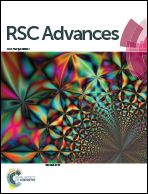Co-precipitation with calcium carbonate – a fast and nontoxic method for removal of nanopollutants from water?†
Abstract
Presence of nanosized contaminants such as engineered gold (Au), silver (Ag) nanoparticles and graphene oxide (GO) in many commercial products are creating environmental concerns owing to their high toxicity. Removal of such nanomaterials (NMs) from water using current technologies is not very efficient owing to the small size and shapes of such pollutants. Here we explore a fast method for the extraction of NMs from aqueous solutions based on in situ co-precipitation of calcium carbonate particles. Removal efficiency was estimated using batch adsorption studies. The co-precipitation method entraps and removes the nanomaterials in a fast and efficient manner to purify water. Microscopic observation and spectrophotometric analyses indicated the extraction and incorporation of NMs into the calcium carbonate precipitate. Complete removal (99%) of metal nanoparticles and graphene oxide was observed within 10 min during the co-precipitation and settling of the solids. This method is efficient to remove nanopollutants from water at low concentration (ppm) levels. Co-precipitation, a simple and scalable purification method using nontoxic material can be scaled up to treat contaminated industrial effluents.


 Please wait while we load your content...
Please wait while we load your content...